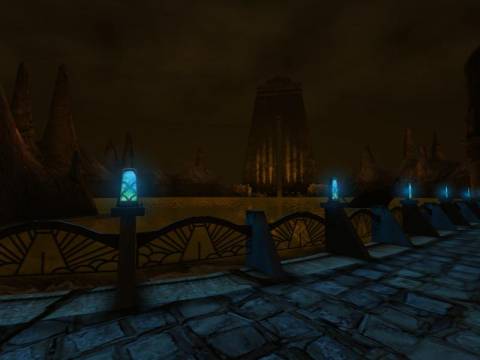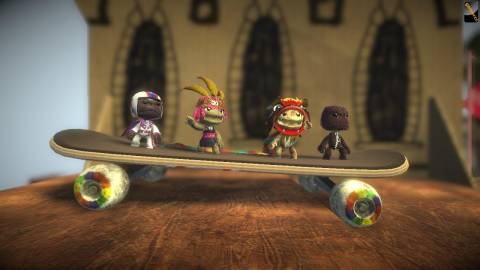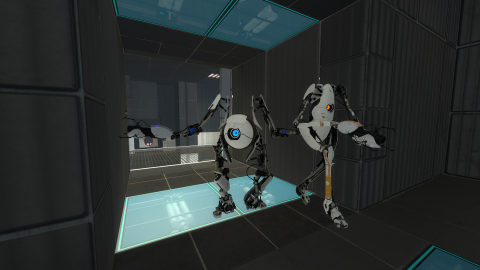18 years ago my parents got me a copy of Myst for the Macintosh. As I wandered through that stack of prerendered images spinning off of our state-of-the-art 3x CD-ROM drive, I was wholly transported. After Myst I followed the developer Cyan (now Cyan Worlds) with great interest. After enjoying great success from the record sales of Myst, the company busied themselves with its sequel. Four years later, this sequel would come to be called Riven, it came on 5 CDs, and it was ten-fold the experience of the original game. If you’ve never played it and you’re looking for a quiet, meditative experience, pick up a copy off Good Old Games.

After Riven is when things really got interesting. Rand Miller of Cyan saw a future in building persistent virtual worlds that people would want to inhabit. Cyan started a project called Mudpie, and for years they labored on what they saw as the future. In interviews, he talked about building a place people would go just to hike together, talk, enjoy the virtual beauty. He talked about a world that would dynamically erode and change over time. In short he was pioneering the concept of an MMO. Trouble is, during the long development of the Mudpie project, the MMORPG would be born, first with Everquest in 1999 and World of Warcraft in 2001. By the time Mudpie was released in 2003 as Uru: Ages Beyond Myst, it was a shadow of Rand’s dream, and its multiplayer component was meet with only confusion by all but Cyan World’s devote fanbase. Rand had thought that players would want to solve puzzle collaboratively with their friends online. They would pay a monthly fee for access to new Ages, or environments to explore. The subscription never caught on, and Cyan Worlds was not able to keep the game going alone. They attempted to partner with the game-subscription service GameTap to reboot the concept, but this did not last long. Uru was later provided as open source for fans to run on their own servers, and in this form it remains. Today Cyan Worlds develops iOS games, a sad end for developer once on top of the world.

Looking back on it now, I wonder. Was the concept of Uru’s cooperative puzzling-solving flawed or simply before its time? Let’s take a look at what has come afterwards in the long, but sparse history of the sub-genre.
There are few games that truly revolve around cooperative puzzle-solving. Before Uru, to my knowledge, there are no notable examples. Afterward, the next big player that I’m aware of is Media Molecule’s LittleBigPlanet. LBP was the first 4-player platformer of its kind, and while a large amount of its levels can be played alone, cooperative puzzle-solving is required to obtain all of its collectibles, useful for building one's own level. After LBP, there are suddenly a large number of multiple-player platformers on the market, including New Super Mario Brothers Wii.
To clarify, there’s likely a number of cooperative games and game modes I’m forgetting which feature a few simple puzzles as a part of their experiences. For example, requiring two players to hit switches at the same time to progress in Resident Evil 5. I’m specifically talking about games that focus on the solution of puzzles through-out the experience and require two players. Yet, by this definition, LBP is a weak entry, since contraptions which require two or more players are almost always optional.

The most recent game I’ve seen in this arena, and the reason I thought to write this post, is the cooperative mode in Portal 2. In this mode, two players cooperate to solve test chambers in the same way they would in single player, only with the advantage of two bodies and two sets of portals.
The most interesting thing about this mode is that it tells the epilogue of the main storyline. Mechanically, it is also an extension of the main game, as it presents a few new combinations of the game’s components which were not explored in the single-player. In general the polish of these test chambers is in line with the single player. Its clear that Valve was very interested in creating a successful multiplayer experience. Gabe Newell has gone on record saying that Valve is likely to focus on multiplayer games going forward, and even went so far as to say they would not create wholly single-player experiences in the future. The business reasoning behind this statement is clear; multiplayer provides replay value, which keeps games from being resold and keeps players buying add-ons. However it is not clear that its best for a story-driven game like Portal.
As much as I like Rand Miller’s beautiful dream of hiking through a storied virtual environment with a close friend, I think the concept is fundamentally flawed. Although it seems like an incredible concept to experience a story in real-time with a friend, in practice the following occurs:
1. Two players, Orange and Blue, enter an environment and begin looking around
2. Player Blue figures out the significance of the surroundings first (the a-ha moment)
3. Player Blue explains everything to Orange and they move on.
The problem is not simply that one player catches on faster than the other. Its that people can operate at significantly different and valid tempos. I suspect that variance between play times for the multiplayer is much less pronounced than it is for the single player. Cooperative play is often about compromise, and neither player wants to feel like they are holding the other up. So the player that enjoys taking things at a slower pace will often miss out on the a-ha moment (2) and end up being dragged along by the hummingbird-tempoed player. The best case scenario is to be paired with someone who shares a similar tempo to yourself, but ultimately there's still pressure related to using someone else's time that goes against the grain of the puzzle-solving genre.
Even as I make this case against cooperative puzzle-solving, I realize that the concept still fascinates me. The games listed above are easily among the most compelling video games I have ever played, and where they don't succeed I see a humble attempt at something new. Still, questions about the future of purely single-player puzzle-solving games are unsettling to me. I know my apprehensions might never be allayed... and so I close, realizing that perhaps the ending has not yet been written.

Log in to comment